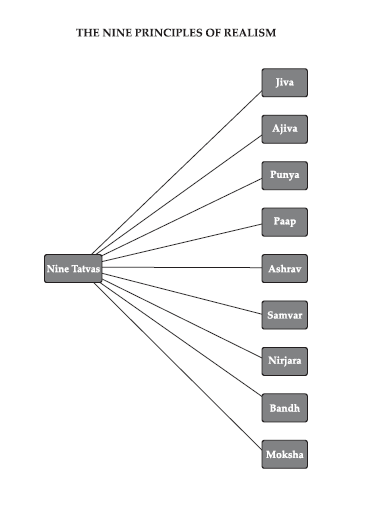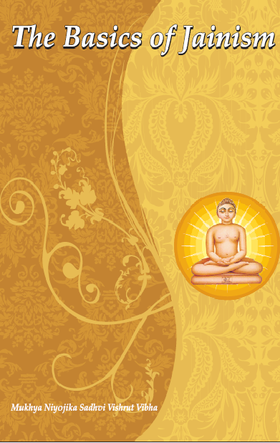The soul passes through an infinite number of stages while travelling from the lowest to the highest stage of spiritual development. According to Jainism these have been classified into fourteen different stages of spiritual development called Gunasthana. So long as the soul is bound by karma, it can never attain emancipation. Jain philosophy believes that there is a ladder with fourteen steps with which a Jiva can climb up to the supreme stage called Moksha.
Sometimes a soul climbing up the ladder of subsidence suddenly slips downward due the rise of karma. In the process of falling down he may attain the state of mithyatva (the first stage).
- Mithyatva Gunasthana:
The first stage is the state of perversity of attitude towards truth. A man blinded from birth is incapable of distinguishing black from white, likewise, a man in the mithyatva gunasthana cannot determine right from wrong.
Even in a soul with perverse belief, there exists some right appraisal of truth which differentiates between living and non-living existences. And this is the reason why even such a state of the soul is designated as the state of spiritual development. Every living being possesses a small degree of partial purity. Even a soul absolutely unfit for emancipation (abhavya) and the soul in the nigoda state also possess at least some degree of purity.
- Sasvadanasamyagdrishti:
-
Samyagmithyadrishti:
- Aviratasamyagdrishti:
- Desavirat:
- Pramattasamyat:
- Apramattasamyat:
In this stage there is complete self-control with self-awareness and there is no negligence in the observance of the vows. One is completely free from remissness and fully absorbed in the self. This stage lasts for an antarmuhurta. After that the aspirants may slip down to the sixth stage.
- Nivritibadaror Apurvakarana:
In this stage the soul attains special purification which he had never experienced before. Here the soul reduces the duration and intensity of the previous karmas. A pair of ladders originates from this gunasthana.
- Upasama Shreni - the ladder of repression
- Kshapak Shreni - the ladder of elimination
- Anivrittibadar:
- Suksama-Samparaya:
At this tenth stage, the soul is free from the influence of all the passions except the very subtle attachment towards his own body. He rises to the eleventh state of absolute subsidence of passions if he has opted for the ladder of repression then he will attain the eleventh stage otherwise directly goes to the twelfth stage, if he opted for the ladder of extirpation.
- Upasantamoha:
This is the eleventh stage of spiritual development where mohaniya karma has been fully pacified. The soul may descend to a lower stage when passion rises again. At this stage, the soul is chadmasta, i.e. enveloped by the influence of karma other than deluding karma. It has suppressed attachment and hence is known to be free from attachment (vitraga). The soul stays for an instant at the minimum in this stage or for an antarmuhurta at the maximum.
- Ksinamoha:
At the twelfth stage of spiritual development, the passions have been completely annihilated. The difference between this stage and the former one is that, in the former stage the soul is in the subsidence state and in the latter stage it is in the destructive state. The soul remains for one antarmuhurta in this stage. As soon as a soul enters this stage, all the mohaniya karmas get destroyed and the soul is free from all passions.
- Sayogikevali:
This is the thirteenth stage. In this stage among the five asravas (mithyatva, avirati, pramada, kasaya and yoga) the first four are totally annihilated. The yoga remains and therefore he is sayogi kevali (with activity). Before attaining this stage, a Jiva destroys gyanavarniya karma, darshanavarniya karma and antaraya karma. The soul is now omniscient (kevali). It has now attained infinite knowledge, infinite faith, infinite bliss and infinite power. However there remains the rise of the four aghati karmas viz. vedaniya karma, ayusya karma, nama karma and gotra karma. The activities of the mind, body and speech still exist, but there is no new bondage.
- Ayogikevali:
This is the last and the final stage of spiritual development. The self is free from all activities and is motionless like a rock. This stage lasts for a very short time. At the end of the stage, the Jiva destroys aghati karma and the soul attains its true state of eternal bliss.
The soul does not pass on to the second stage of development from the first, but only halts at it while scaling down from some higher stage of spiritual development. In this stage, one may have some taste of righteousness.
A person of mixed belief has an inclination to the right as well as the wrong like the inseparable taste of the mixture of sugar and curd. He is free from mithyatva but not settled in samyaktva. The soul stays in this stage for an antarmuhurtafspilt of a second), and later on either falls back to the first stage or rise up to a higher stage of right vision.
In this stage, a person has right vision and attitude towards the realities, but due to lack of self-restraint, he is non-abstinent. From this stage, the soul can rise to the higher stages only by self-control and self-discipline.
This is the fifth stage of right belief with the capacity for partial abstinence. At this stage, the soul is not capable of complete abstinence from sinful deeds because of the rise of the third type of kasaya (pratyakhyanavarana). This stage of spiritual development is achieved in a life of a Jain shravak (a layman), who realizes the importance of conduct and practices the twelve vows of a Laity.
The sixth gunsthana can be attained by a monk who is completely aware of the five mahavratas he vowed to observe during renouncement. He then spends his life in penance and meditation, and is detached from worldly matters.
A soul's maximum stay at this stage is of an antarmuhurta. The soul performs the process of apurvakarana while climbing up either of the two ladders at this stage.
The ninth stage of development is anivrittibadar. There is a slight possibility of an attack from gross passions. At this stage, the aspirant gains control over subtle forms of maya and reaches above the sense of being a male or a female.

